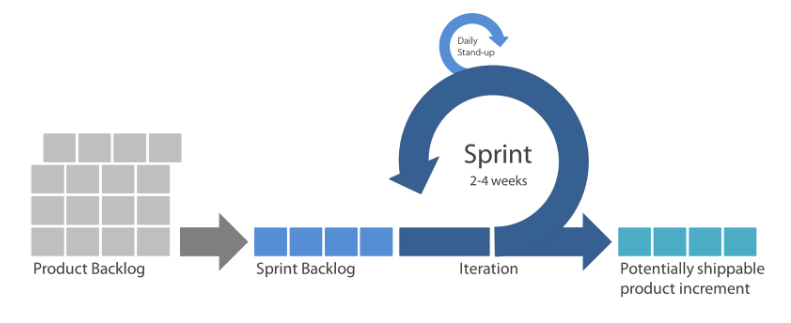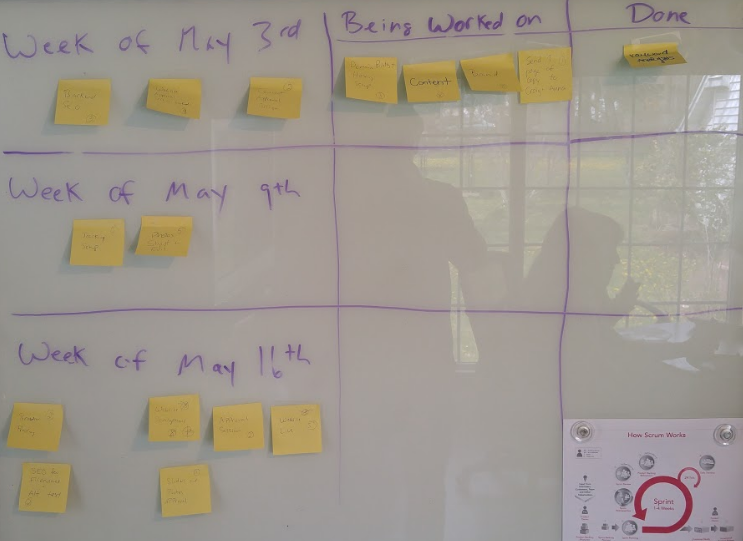How to Do Twice as Much in Half the Time With Scrum
By Paul Demarco
About 6 months ago when scrolling through our Audible library, we came across a recommended book called “Scrum”. The book claimed that it could help you do twice the work in half the time. After reading that, we had to go through this book to see if the claim was true.
After firing through the book in less than a week, it was clear that J.J. Sutherland was onto something. He had created this Scrum methodology to be used mainly for software development in Silicon Valley and, after some incredible success there, people started realizing that it could be used for many other applications.
I am not going to go into the entire Scrum process today, you can see the image above to get the basic outline and if you are interested in really taking this all in, I would highly recommend reading this book. This post will take you through our short journey of how we have adopted this process.
How We Do Marketing at Intrigue
I want to start by giving some insight on how we typically operate marketing campaigns on a regular basis at Intrigue. Essentially we create a Marketing Action Plan for a client that lays out each line item of what we promise to complete for our clients, month by month, over the next 12 months. They typically include initiatives such as:
- Blogging
- Social Media Posting
- Email Marketing
- Online Advertising
- Graphic Design
- And more
In each one of these areas we have specialists that are assigned to that portion of the campaign for each client.
Every month, each team member working on that account is responsible for getting content for their month’s work, performing their portion of the initiatives, getting it approved by the client, and getting it live to the audience we are trying to target. Each team member at Intrigue is specialized in a certain area, which means if you are responsible for email marketing, you will have up to 50 clients each month who need to get an email out the door.
When you look at this model, I see two fundamental problems with it.
- There is an incredible amount of communication back and forth with each client from multiple team members.
- Every month, each team member is having to get back into the headspace of the client they are performing tasks for. For example, if we are working with a client that specializes in insurance, and we are writing a blog for them every month, each month we have to get our head back into that mindset for the day that we are writing content for them that month.
Overall, this is a ton of heavy lifting, and we are defying the rules of Flow that Daniel Pink talks about in Drive.
So after coming across Scrum, we decided this was a process we had to try in our business model. We took the book, implemented it into our Leader Building program, and within 5 weeks, the entire Operations team had read the book, followed by the rest of the team completing the book as well. We were all speaking the same language.
This Is How We Did Marketing Using Scrum

So here is how we decided to adopt Scrum into our business with some remarkable successes and some great failures that we got to learn from.
1. Plan 6-12 Months of Work Up Front
We had some feedback from clients that there was too much back and forth on a regular basis and too much ‘broken telephone.’ So we approached those clients first and said, ‘How do you feel about the idea of doing the next 6 months of our work for you up front?’ We would come in, have a big planning session to understand the strategy and content for the next 6 months, go away, work on everything we discussed, and come back two weeks later to present everything that is completed. Upon approval, we will schedule it out and revisit the campaign 6 months to discuss the results and plan for the following 6 months. There was immediate buy-in.
2. Have an Internal Planning Session
After a session with the client, the team comes back and has the planning session, ideally within 24 hours, on how we are going to implement everything. We discuss who is responsible for what and create a backlog of every initiative we needed to complete. In the book, it talks about doing the backlog on sticky notes, which we have done verbatim. We have whiteboards in our office dedicated to client projects and on each one there is a section for ‘backlog’, ‘being worked on’, and ‘done’. Each sticky note also has a numerical value from a Fibonacci sequence that they explain in the book so we can track progress over time.
We set the length of what is referred to as a sprint, which is the time we plan to complete all of the work that we discussed and agreed to with the client. Ours are typically three weeks.

3. Hold Daily Stand Ups
Every day we dedicate the first half hour to having a quick stand up meeting with each group on each of the client projects. Each team member is asked three questions. What did you work on yesterday for this project? What are you working on today for this project? Is there anything in your way?
These happen each day until the project is completed. We also take this time to move sticky notes to the appropriate places. We have been delighted by the satisfaction we get when we get to move the backlog sticky notes through the process. They take us about 5-10 minutes per project.
4. Present the Finished Project to the Client
After we have completed all the work in the 3 week Sprint, we hold another meeting with our client, which was already booked during the previous session to hold us accountable to that finish line. We present everything we have completed, get feedback, and get approval to move ahead with implementing everything our team created.
5. Sprint Retrospective
The last thing we do is have a meeting, with all team members on the project, where we ask ourselves: What went well during this sprint? What didn’t go well during this sprint? What is the one thing we can take from this experience that we can improve for the next sprint? The piece that comes from the last question is what is referred to as the Kaizen in the book.
Overall, we have really enjoyed working in this process and have had some incredible success along with great learning.
Here Is Where We Have Won:
1. We are Completing 6-12 months of Work in Three Weeks
This part has so many implications. This helps us avoid the constant back and forth with our clients by multiple team members every single month. Our clients love this process because they get to see everything up front and don’t have to worry about the monthly task of checking content and having to approve everything.
2. Clients Love the Process
Not only do clients love not having the back and forth, but they also love the quality of work that they are seeing. In every approval session we have held so far, we have gotten approval on everything that we present, which was not our experience when we were completing work every month for these clients.
3. Our Team Loves the Process
Our team is finding that they are more ‘in the loop’ on the projects they are working on. They understand the big picture of what the clients are trying to accomplish and they are a part of the process every step along the way. They are also finding that they are producing higher quality work in much less time. Being able to focus on one type of business over a three week period lets them stay in that mindset, get into flow, and accomplish so much more during that time.
Oh, and they like being able to focus on what they do best everyday as well which is performing their initiatives versus trying to hunt people down on the phone for content and approval.
Here is Where We Have Failed and Learned:
- The biggest Kaizen we have had is around client buy-in. When we tell clients that we want to change the process and that we need specific times from them up front so it can save everyone time in the long run, and we book all the meetings out, we win with this process every time. On the flip side, we tried putting some clients into this process without getting their full buy-in up front, and we will just say that in every one of those instances, we didn’t complete all of our sticky notes on the whiteboard in the sprint timeline we laid out for ourselves.
- The other big challenge we have had is balancing this new process which demands more work of everybody up front. We have had to balance all of the monthly work that we have ongoing and promised to clients. We are essentially demanding more of ourselves on a monthly basis until we can transition the large majority of our clients into this methodology, which will likely take 12-18 months.
This has been our journey through Scrum to date, so hopefully you were able to take something from this that you can implement into your business or your life. As I mentioned, if this peaks your interest, I would highly recommend going through the book to get a full understanding of the process and see how it has been utilized across so many different platforms across the world.
You can contact our team to learn more about how we do marketing at Intrigue.
Start learning how to grow your business